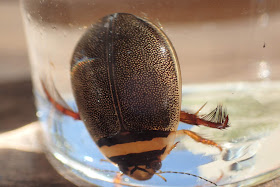We have completed only three visits so far and recorded 358 species. What's remarkable about this is although the time was split between three days in April, May and June, it's only about 11 hours worth of recording. We went on a site visit there last week and I did ONE pond dipping sample and pulled out this beauty. It's Graphoderus cinereus, the IUCN Vulnerable water beetle with only six records from Sussex, all in East Sussex, none of which are from this century. It's a new one for me too. A new genus in fact. Of the three species on the British list, this is the commonest one (of the other two, one is extinct and the other at only one site more or less). I was very pleased with the way the photos came out!
There were Great Silver Water Beetle (both adult and larva) in the same net along with dozens of other invertebrates. We've recorded over 110 beetles so far in fact. All in all, 30 invertebrate species we have recorded have conservation status (8.25%).
We also picked up Donacia crassipes, only the 3rd time I have recorded this nationally scarce reed beetle that feeds on water-lilies (which are abundant in the ditches there). Here is a photo of one when I found them at Woods Mill when the lake was dry five years ago.
There were Great Silver Water Beetle (both adult and larva) in the same net along with dozens of other invertebrates. We've recorded over 110 beetles so far in fact. All in all, 30 invertebrate species we have recorded have conservation status (8.25%).
We also picked up Donacia crassipes, only the 3rd time I have recorded this nationally scarce reed beetle that feeds on water-lilies (which are abundant in the ditches there). Here is a photo of one when I found them at Woods Mill when the lake was dry five years ago.
And of course the site is great for 13-spot Ladybirds, Atylotus rusticus and the cool cranefly Limnophila pictipennis. In fact, the next visit is tomorrow and I just can't wait to see what we find this time.




No comments:
Post a Comment